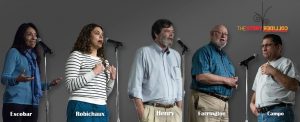Story Collider Unites Community, Research, and Restoration
– May 11, 2017
When the news [flashed] across the TV screen about the Deepwater Horizon and the explosion and the loss of eleven lives […] my reaction was “not again.” – John Farrington
Many people have heard of the 2010 Deepwater Horizon oil spill and may have even kept up with its impacts in the following years. But how many have experienced a first-hand account from someone close to the spill? C-IMAGE recently partnered with The Story Collider, a science-oriented storytelling podcast and live show, to organize their second annual storytelling event highlighting the experiences of researchers and Louisiana natives during and after the spill.
Story Collider producer Ari Daniel and artistic director Erin Barker hosted the event, which took place during the 2017 Gulf of Mexico Oil Spill and Ecosystem Science Conference in New Orleans, Louisiana. It featured marine researchers John Farrington and Elva Escobar, Louisiana fisherman Robert Campo, restoration analyst Estelle Robichaux, and disaster response specialist Charlie Henry.
C-IMAGE Program Manager Benjamin Prueitt explained that a major goal for the event was to connect the speakers’ stories with both conference attendees and the local community. “Deepwater Horizon is part of Gulf history and hit Louisiana hard, both environmentally and economically,” Prueitt said. “The personal connection between the storytellers and the audience shows the commitment GoMRI’s consortia have on improving society’s understanding and response to oil blowouts.” The C-IMAGE team promoted the event on local media outlets and regional Facebook ads and were pleased to see the interest in the event.
Farrington and Escobar approached the spill from a researcher’s perspective. Escobar, the director of the Universidad Nacional Autónoma de México’s Instituto de Ciencias del Mar y Limnología, described her first excursion in a deep-sea submersible, which shaped how she conducts and views her research today. “I see the ocean as a transversal line through different fields. In one extreme, I see us scientists and at the other extreme the fishermen, and in between are all these other people that have to learn about the ocean [sic],” she said.
Farrington, Dean Emeritus at the Woods Hole Oceanographic Institution and a GoMRI Research Board member, explained that the Deepwater Horizon event reminded him of his experience with the 1979 Ixtoc I spill. The work of scientists researching and responding to Ixtoc I significantly informed future spill response, including the National Academies’ 1985 Oil in the Sea review and the Gulf War oil spill response, and emphasized the need for open dialogue between scientists, government officials, and the public.
Campo, Robichaux, and Henry related personally to the disaster as Louisiana natives. Campo, a fourth generation oyster fisherman and Campo’s Marina owner, described his struggle to maintain his family’s 117-year-old business after the spill impacted their oyster reefs. “I couldn’t see myself doing anything else but fishing for a living,” he said. “What makes me do what I do is because Louisiana’s home.” Nearly seven years after the spill, many of Campo’s reefs still have not recovered.
Robichaux complemented Campo’s reflections by relating the spill’s negative environmental effects to a loved one’s progressing illness. Watching the person and place that she loved deteriorate permanently affected her and inspired her to fight for wetland protection and restoration. When the BP settlement money for large-scale restorations came through, she felt empowered in her work as a restoration project analyst for Environmental Defense Fund and finally became hopeful for the coastline’s recovery.
Henry, the Director of NOAA’S Gulf of Mexico Disaster Response Center, gave an insider’s perspective on the way responders handle major spills. He acted as a scientific liaison to help responders assess what was spilled, where it went, what was impacted, how severe the impact would be, and what could be done to mitigate the impact. “Emergency spill response is a lot of work, a lot of sleepless nights, a lot of waiting to get ready to go home. And that’s what we do, because we think we make a difference. […] I’ve never regretted any part of this job,” he said.
The five stories brought together new experiences, emotional memories, and lessons learned surrounding the Deepwater Horizon spill. C-IMAGE will host another Story Collider at the 2018 Gulf of Mexico Oil Spill and Ecosystem Science Conference in New Orleans, Louisiana. Full recordings of these stories and stories from the 2016 event are available at the C-IMAGE YouTube page.
************
This research was made possible in part by a grant from the Gulf of Mexico Research Initiative (GoMRI) to the Center for the Integrated Modeling and Analysis of Gulf Ecosystems II (C-IMAGE II).
The Gulf of Mexico Research Initiative (GoMRI) is a 10-year independent research program established to study the effect, and the potential associated impact, of hydrocarbon releases on the environment and public health, as well as to develop improved spill mitigation, oil detection, characterization and remediation technologies. An independent and academic 20-member Research Board makes the funding and research direction decisions to ensure the intellectual quality, effectiveness and academic independence of the GoMRI research. All research data, findings and publications will be made publicly available. The program was established through a $500 million financial commitment from BP. For more information, visit https://gulfresearchinitiative.org/.
© Copyright 2010- 2017 Gulf of Mexico Research Initiative (GoMRI) – All Rights Reserved. Redistribution is encouraged with acknowledgement to the Gulf of Mexico Research Initiative (GoMRI). Please credit images and/or videos as done in each article. Questions? Contact web-content editor Nilde “Maggie” Dannreuther, Northern Gulf Institute, Mississippi State University (maggied@ngi.msstate.edu).






